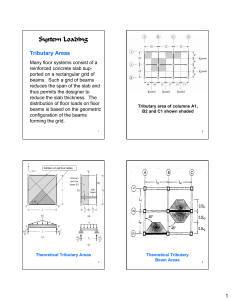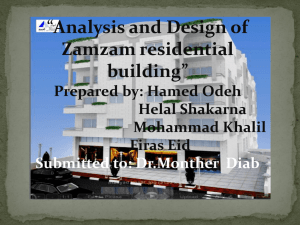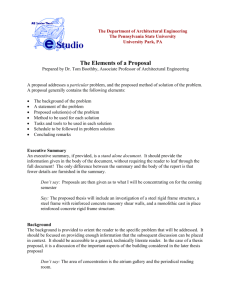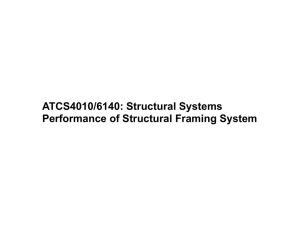Ch.4 Modeling
advertisement
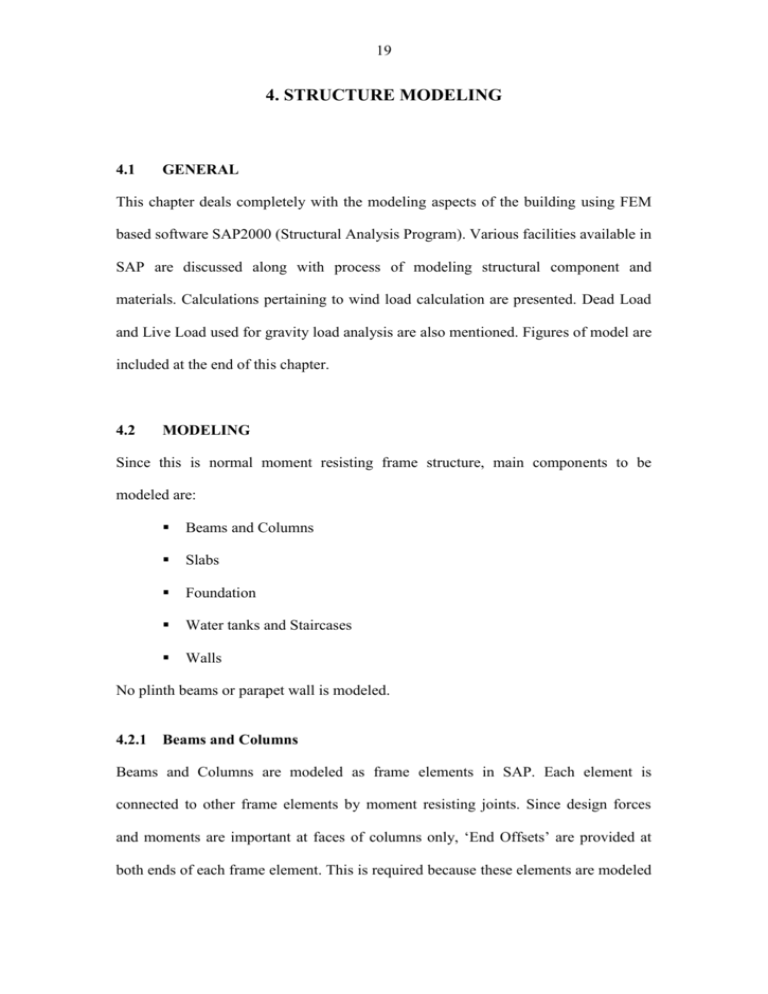
19 4. STRUCTURE MODELING 4.1 GENERAL This chapter deals completely with the modeling aspects of the building using FEM based software SAP2000 (Structural Analysis Program). Various facilities available in SAP are discussed along with process of modeling structural component and materials. Calculations pertaining to wind load calculation are presented. Dead Load and Live Load used for gravity load analysis are also mentioned. Figures of model are included at the end of this chapter. 4.2 MODELING Since this is normal moment resisting frame structure, main components to be modeled are: Beams and Columns Slabs Foundation Water tanks and Staircases Walls No plinth beams or parapet wall is modeled. 4.2.1 Beams and Columns Beams and Columns are modeled as frame elements in SAP. Each element is connected to other frame elements by moment resisting joints. Since design forces and moments are important at faces of columns only, ‘End Offsets’ are provided at both ends of each frame element. This is required because these elements are modeled 20 as line elements but actually they have finite size. Stiffness of beam section is practically infinite from center to center intersection point with column to the face of the column section, but SAP – without End Offset command – assumes same as stiffness there same as at any other section. End Offsets eliminate this by ensuring that two ends of frames are rigidly connected at beam column junction. Fig. 4.1 Use of End-Offsets at Beam-Column Junction 4.2.2 Slabs Slabs are modeled as shell element whose bending and torsion thickness are same and equal to slab thickness. Since stresses in slabs are not significantly affected by lateral loads, they are designed for gravity load combination only. Thus purpose of modeling slabs here is not to determine design forces but to: 1. Uniformly distribute DL and LL. This is expected to more accurate then triangular or trapezoidal distribution of loads on beams based on 450 dispersion. 21 2. Contribute to seismic weight of the floor thus eliminating the need to lump masses at each floor. 4.2.3 Foundation In the absence of any geotechnical information, it is assumed that building is supported on rock. Thus foundation is modeled as fixed at the top of the raft foundation at a depth of 1.5m below ground level and 1.95m below ground floor level. 4.2.4 Water Tanks and Staircases Load of the water tank is taken as uniformly distributed load on the slab of tank floor. Also this mass is lumped with floor mass for seismic analysis. Similarly load on and due to staircases is also considered UDL. 4.2.5 Walls Non-structural brick infill walls do not play any contribution in load resistance under vertical loads but tend to act like inclined strut under lateral loads due to distortion in shape of frame section. However, brick infill is not modeled as inclined strut in this analysis and only self-weight of wall is distributed as UDL on beams. 4.3 MATERIAL For the purpose of analysis following material properties are assumed for concrete: Grade of Concrete = M25 Grade of Steel = Fe415 Unit weight = 25 kN/m3 Unit mass = 2.55 tonnes/m3 Young’s Modulus of Elasticity = 5000 f ck = 25 × 106 kN/m2 22 Poisson’s Ratio = 0.15 For Response Spectrum analysis of the structure, seismic weight of each floor has to be lumped to the floor center of mass. This can be avoided if each element is given its self weight which will be automatically accounted by SAP. But SAP does not take care of the external LL and DL though they contribute to the seismic weight. This can be resolved in either of the two ways: 1) Lumping additional mass at center of mass of floors 2) Increasing self weight to account for this mass – this can be done without increasing section dimensions and hence stiffness, by increasing material density. Thus material properties become function of element dimension and imposed unaccounted load. For example, modified unit weight of slab concrete = 25.0 + And modified unit weight of beam concrete = 25.0 + 4.4 SECTIONS 4.4.1 Beam and Column Sections externalUDL slab _ thickness externalUDL bD Frame sections can be defined by selecting the shape, material, dimensions and reinforcement details. All common shapes are available while standard sizes of steel sections are also enlisted. It has been found that results of analysis are independent of frame element reinforcement. Thus default reinforcement is accepted for analysis in this case. 23 4.4.2 Slab Sections Shell sections can be defined by selecting material and thickness. Options of modeling element as shell or plate are available. 4.5 LOADING Different load cases are defined as follows: 4.5.1 Dead Load Apart from the self weight, following imposed dead loads are considered in the analysis: ‘Finishing’ on terrace = 1.5 kN/m2 ‘Partition wall’ on terrace = 1.0 kN/m2 ‘ Finishing’ on inner apartment floor = 1.0 kN/m2 ‘Partition wall’ on inner apartment floor = 1.0 kN/m2 4.5.2 Live Load Following imposed live loads are considered in analysis: LL on accessible terrace = 1.5 kN/m2 LL due to 1.2m water height = 11.77 kN/m2 LL on living room, bedroom, kitchen floors = 2.0 kN/m2 LL on balconies, verandas = 3.0 kN/m2 4.5.3 Wind Loads 4.5.3.1 Calculation Procedure: Wind loads are equivalent static load representative of the pressure induced by wind on the structure. According to IS 875(Part III):1987, India is divided into 6 wind 24 zones of basic wind speeds (Vb) 33, 39, 44, 47, 50, 55 m/s. For cyclonic regions, this speed is to be increased by 15%. Design wind speed at height z is given by, Vz (m/s) = Vb × k1 × k2 × k3, where k1 = probability factor / risk coefficient – function of mean probable design life of structure and basic wind speed k2 = terrain, height and structure size factor – function of terrain category (based on obstruction to wind), building size (based on greatest horizontal or vertical dimension) and height from ground level k3 = topography factor – function of upwind ground slope Design wind pressure at height z is given by, Pz (N/m2) = 0.6 Vz2 Wind load on the exposed area can be calculated as, F = Cf Ao Pz, where Cf = Force coefficient – function of dimensions of the building Ao = Exposed area over which wind is acting Thus this load is applied on the building and static elastic analysis is carried out using SAP2000. 4.5.3.2 Wind Load Calculations: Basic wind speed, Vb = 50 × 1.15 = 57.5 m/s (due to cyclonic effect) k1 = 1.0 for general buildings of mean design life of 50 years for all Vb k3 = 1.0 for flat ground surface Since maximum dimension (32m) is between 20.0m to 50.0m, it is Class B building. 25 Considering Terrain Category 3, wind pressure at various heights can be obtained as presented in Table 4.1 Table 4.1 Design wind pressure Z (m) k2,lower k2,higher k2 (max) Vz (m/s) Pz (kN/m2) 0.00-10.00 0.88 0.88 0.88 50.60 1.54 10.00-19.95 0.88 0.98 0.98 56.35 1.91 19.95-25.95 0.98 1.01 1.01 58.08 2.02 Fig. 4.2 Wind Load Calculation When wind is normal to longer side, a / b = 20.47 / 32.46 = 0.638 h / b = 25.95 / 32.46 = 0.800 from Chart provided in IS 875(Part III):1987, Cf = 1.2 When wind is normal to shorter side, a / b = 32.46 / 20.47 = 1.586 h / b = 25.95 / 20.47 = 1.268 so, Cf = 1.08 UDL due to wind on a floor, 26 = 1.20 Pz × half of sum of floor to floor heights above and below (normal to longer side in plan) = 1.08 Pz × half of sum of floor to floor heights above and below (normal to shorter side in plan) 4.5.4 Earthquake Loads For zone IV, following values of parameters is used in defining Response Spectrum, Zone factor, Z = 0.24 Response Reduction Factor, R = 5.0 for ductile detailing following provisions of IS 1392:1993. Response Spectrum function is inputted as Ah×9.81 vs. T for T ranging from 0.00 to 4.00. Complete Response Spectrum function is tabulated in Appendix-A. Response Spectrum case ‘EQ’ is defined with above function and unity multiplier for Ux and Uy and zero for Uz. Total numbers of modes, including residual mass modes, are ten. Modal combination as well as directional combination is achieved by SRSS rule. 4.6 LOAD COMBINATIONS Following load combinations are considered to evaluate worst case design loads as prescribed by IS 456:2000 and IS 1893:2002. COMB1 = 1.5 (DL + LL) COMB2 = 1.2 (DL + LL + EQ) COMB3 = 1.2 (DL + LL - EQ) COMB4 = 1.2 (DL + LL + WIND) COMB5 = 1.2 (DL + LL - WIND) COMB6 = 1.5 (DL + EQ) 27 COMB7 = 1.5 (DL - EQ) COMB8 = 1.5 (DL + WIND) COMB9 = 1.5 (DL - WIND) COMB10 = 0.9 DL + 1.5 EQ COMB11 = 0.9 DL - 1.5 EQ COMB12 = 0.9 DL + 1.5 WIND COMB13 = 0.9 DL - 1.5 WIND Design will be based on maximum of all these. 4.7 MODEL FIGURES 4.7.1 Building Models Fig. 4.3 Three-Dimensional view of the model – Perspective View 28 Fig. 4.4 Three-Dimensional view of the model – along (-) Y axis 29 4.7.2 Plan of the Building Fig. 4.5 Plan of the building 30 4.7.3 Frame Sections XZ Plane @ Y = -1.34 XZ Plane @ Y = -6.1 XZ Plane @ Y = -7.28 XZ Plane @ Y = -10.56 XZ Plane @ Y = -14.03 XZ Plane @ Y = -15.93 Fig. 4.6 Frame section in XZ plane 31 Fig. 4.7 Frame Section in YZ Plane @ X = 1.34 & 19.13 4.8 SUMMARY In this chapter, all aspects related to modeling of this building in SAP2000 packages are discussed. Modeling considerations of various structural components like beam, column, slab, wall, foundation etc. are presented. Material properties used for analysis are also enlisted along with method for necessary change in material density to take into account external loads into earthquake load analysis. Beam, Column and slab section are defined for appropriate material properties and structural action. Calculation for estimating equivalent static wind load is shown along with dead and live load values used for corresponding analysis. Chapter is concluded with specifying load combination for design and presenting figures of SAP model of the building.

